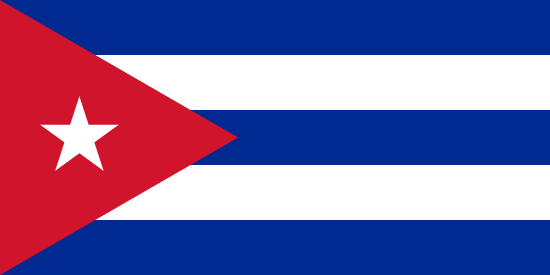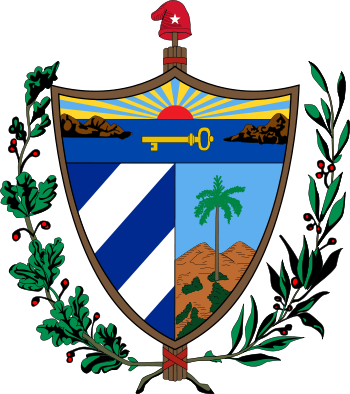Cuba is the largest island in the Caribbean, and as large as the other islands combined. The country has long been ruled by Fidel Castro, and despite internal and external pressures, Cuba has remained relatively unchanged since the 1950s.
| Capital: | Havana |
| Biggest city: | Havana |
| State: | republic |
| Language: | Spanish |
| Religion: | catholicism |
| Surface: | 100 860 km² |
| Population: | 11.3 million (2013) |
| Population density: | 103 residents per km² |
| Life expectancy: | 77 years |
| Illiteracy: | 0% |
| Currency: | Cuban peso (CUP) 1 peso = 8.40 kr |
| GDP per capita: | $ 9,500 (2008) |
| Time difference: | -6 hours |
| Electricity: | 110/220 V AC 60Hz |
| National Day: | July 26 |
| Country area code: | 53 |
| 2-Letter country abbreviation: | CU (See more abbreviations on Abbreviationfinder) |
| Business: | service sector 48%, industry 29%, agriculture 23% |
| Climate: | tropical, mitigated by trade winds; rainy season from May to October |

The country has survived more than 50 years of US sanctions, and is today one of the world’s few remaining communist countries. In addition to the main island of the same name, Cuba also has several small islands, most of them uninhabited.
Since the 1959 revolution, Cuba’s society has been dominated by Fidel Castro and the Communist Party. Castro seized power in 1959 through the Cuban Revolution, turning the country into a socialist one-party state. Cuba had financial support from the Soviet Union for many years, but when the Soviet Union collapsed in the 1990s, aid ceased, and Cuba ended up in an economic crisis.
The United States has a US military base, the Guantánamo base, in Cuba. It is located on the Gulf of Guantánamo in southeastern Cuba. It is not possible to visit the Guantánamo base from Cuba, but you can get permission from the United States to visit the military base. Fidel Castro has tried to retake the area, but has failed. The United States currently pays an annual rent for the area, but Cuba refuses to accept the money as they believe the area is occupied.
The capital Havana is known for its colonial buildings, and the old town has long been a UNESCO World Heritage Site. In Trinidad, on the southern coast of Cuba, there are also many beautiful buildings and memories from the colonial era. UNESCO has declared the entire city a World Heritage Site.
The James Bond film “Die Another Day” takes place partly in Cuba, but these scenes are in fact filmed in Andalusia, Spain. However, the movie “Buena Vista Social Club” was filmed in Cuba.
The book “The Old and the Sea” by Ernest Hemingway is about a Cuban fisherman, and takes place in Cuba. The author himself lived in Cuba for periods, where he also wrote the book. Hemingway’s home is now a museum, and the bars where he was a regular visitor have long been popular tourist destinations.
ELECTRICAL OUTLET
Electricity and electrical outlets in Cuba
Voltage: 110 V / 220 V
Frequency: 60 Hz
Type of plug: A, B, C
Need an adapter: No, you do not need an adapter.
CLIMATE AND WEATHER
Weather in Havana
| Climate | Jan | Feb | Mar | Apr | May | Jun | Christmas | Aug | Sep | Oct | Nov | Dec |
| Average temperature °C | 26 | 26 | 26 | 27 | 28 | 29 | 29 | 30 | 30 | 29 | 28 | 27 |
| Day °C | 26 | 27 | 28 | 30 | 31 | 32 | 32 | 32 | 31 | 30 | 28 | 27 |
| Night °C | 16 | 17 | 18 | 19 | 21 | 22 | 22 | 22 | 22 | 20 | 19 | 18 |
| Rain (mm) | 20 | 10 | 40 | 30 | 70 | 80 | 50 | 70 | 70 | 80 | 40 | 30 |
| Rainy days | 6 | 5 | 5 | 6 | 8 | 14 | 12 | 13 | 13 | 10 | 7 | 6 |
| Soltim / day | 7 | 8 | 9 | 10 | 10 | 10 | 11 | 10 | 9 | 8 | 8 | 8 |

Cienfuegos
Cienfuegos is a city in Cuba with 163,824 residents (2004). The city has one of the country’s most important ports and is also the center of the country’s industrial development.
The city’s historic center has been a UNESCO World Heritage Site since 2005.
Havana
According to Countryaah, Havana is the capital of Cuba. It has 2,156,650 residents (2007) and is thus the country’s largest city. Before the revolution had triumphed in 1959, and especially between 1915 and 1930, tourism was a major source of foreign exchange for Cuba. Havana, where there was a voluptuous attitude to everything connected with pleasure, was the most popular destination in the Caribbean, especially for the Americans, who tried to avoid the restrictions imposed during the Prohibition era.
It was the traditional union between tourism and a world of gambling and prostitution that led the revolutionary government established in 1959 to see this sector as a social scourge that should be abolished altogether. Many bars and gaming houses were closed after the victory of the revolution, and a new state institution, the National Institute of Tourism (el Instituto Nacional de la Industria Turística), took control of many premises (formerly affordable only for the rich) and put them within reach of the population.
With the deterioration of relations between Cuba and the United States and the introduction of a trade embargo against the island in 1961, tourism witnessed a drastic decline and did not recover by far to a volume similar to that which existed before the revolution until 1989. The revolutionary government in general, and Fidel Castro in particular, was from the beginning opposed to a meaningful development of the tourism industry, and associated this area with extravagance and criminal activity from the past. In the late 1970s, Castro changed his position on this issue. In 1982, the Cuban government approved a law on foreign investment that opened up several sectors, including tourism, to foreign capital.
By forming companies supported by foreign investment, Cuba began to attract development capital for the development of hotel operations and succeeded in increasing the number of tourists from 130,000 (1980) to 326,000 (at the end of the decade).
As a result of the collapse of the Soviet Union and its allies in Eastern Europe in 1989 and the early 1990s, Cuba sank into a severe economic crisis and was in dire need of foreign exchange. The solution was, again, to resort to tourism, and the Cuban government invested significant sums in the tourism sector to attract visitors to the country. As a result of these large investments, in 1995 the tourism industry had become the largest source of income for Cuba.
Old Havana with fortifications was added to the UNESCO World Heritage List in 1982.
Santa Clara
Santa Clara is a city in central Cuba, and is the administrative capital of the province of Villa Clara. The city has 207,963 residents (2007). Santa Clara was the site of a decisive victory in 1958, in which Fidel Castro defeated Batista’s government forces, after which Castro marched into the capital Havana shortly after Batista fled the country.
Santiago de Cuba
Santiago de Cuba is a city in southeastern Cuba and is the country’s second largest city with 426,618 residents (2007). It has an excellent port and a diverse industry. The city is also an important cultural, educational and tourist center. Santiago de Cuba was built in 1514 and was the capital of Cuba in 152356.
The San Pedro de la Roca was named a UNESCO World Heritage Site in 1997.
Trinidad
Trinidad is a city in central Cuba with 73,466 residents (2004). Trinidad was founded in 1514 by Diego Velázquez de Cuéllar under the name Villa De la Santísima Trinidad. It is one of the best-preserved cities in the Caribbean from the time when the sugar trade was the main industry in the region.
Today, the tobacco industry is Trinidad’s main occupation. The older parts of the city, which are an area for tourist groups, are very well preserved. In contrast, the other parts of the city are very dilapidated. Outside the city is the Ancón Peninsula with a long sandy beach (Playa Ancón) and several tourist hotels. Ancón was one of the first new tourist resorts to be developed in Cuba after the 1959 revolution. The
city, together with the nearby Valle de los Ingenios, was added to the UNESCO World Heritage List in 1988.
Varadero
Varadero is a tourist resort in Cuba, about 140 km east of Havana. Many of the hotels are run in whole or in part by foreign companies, and Varadero Beach boasts a 20-kilometer sand dune. The city has about 20,000 residents (2007), where all more or less work with tourism.